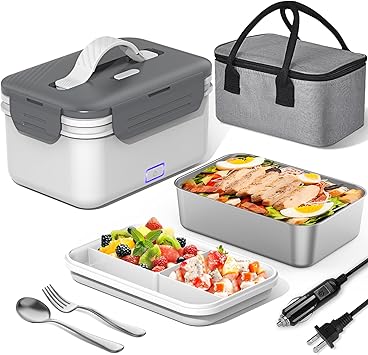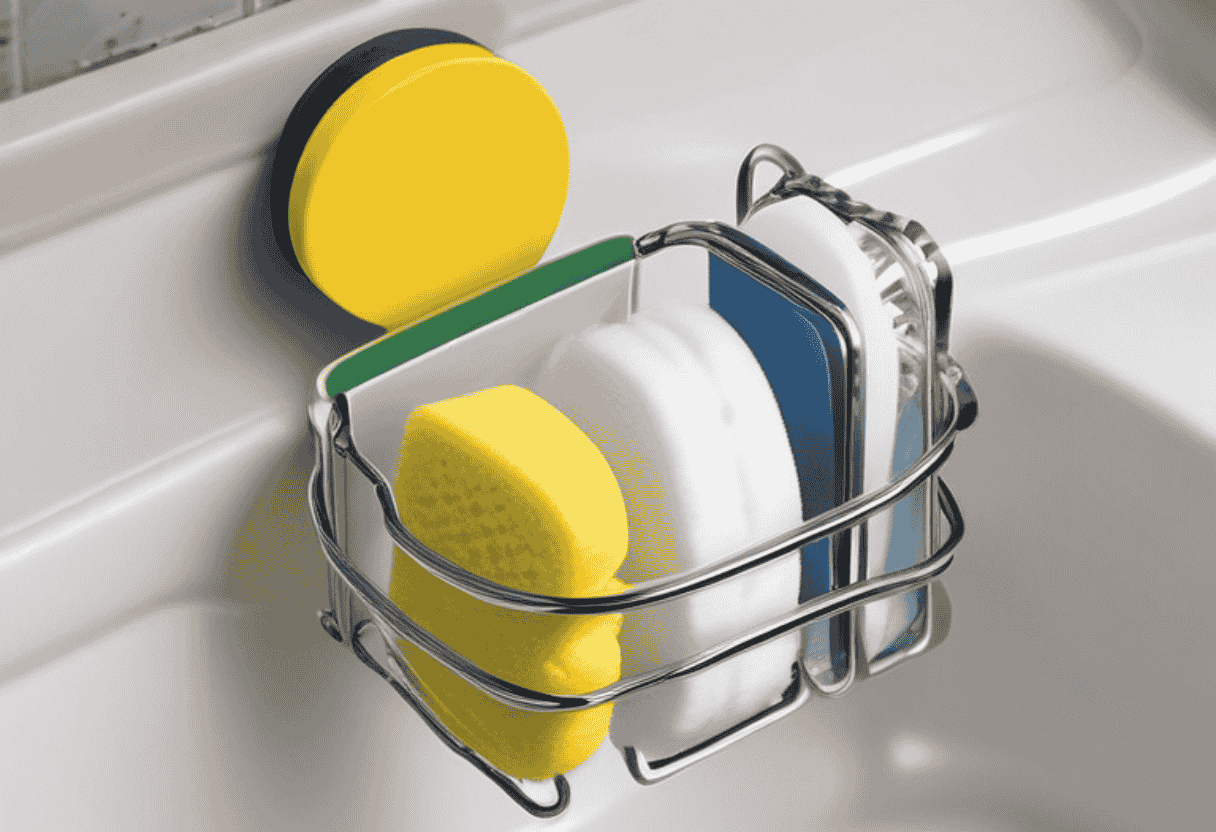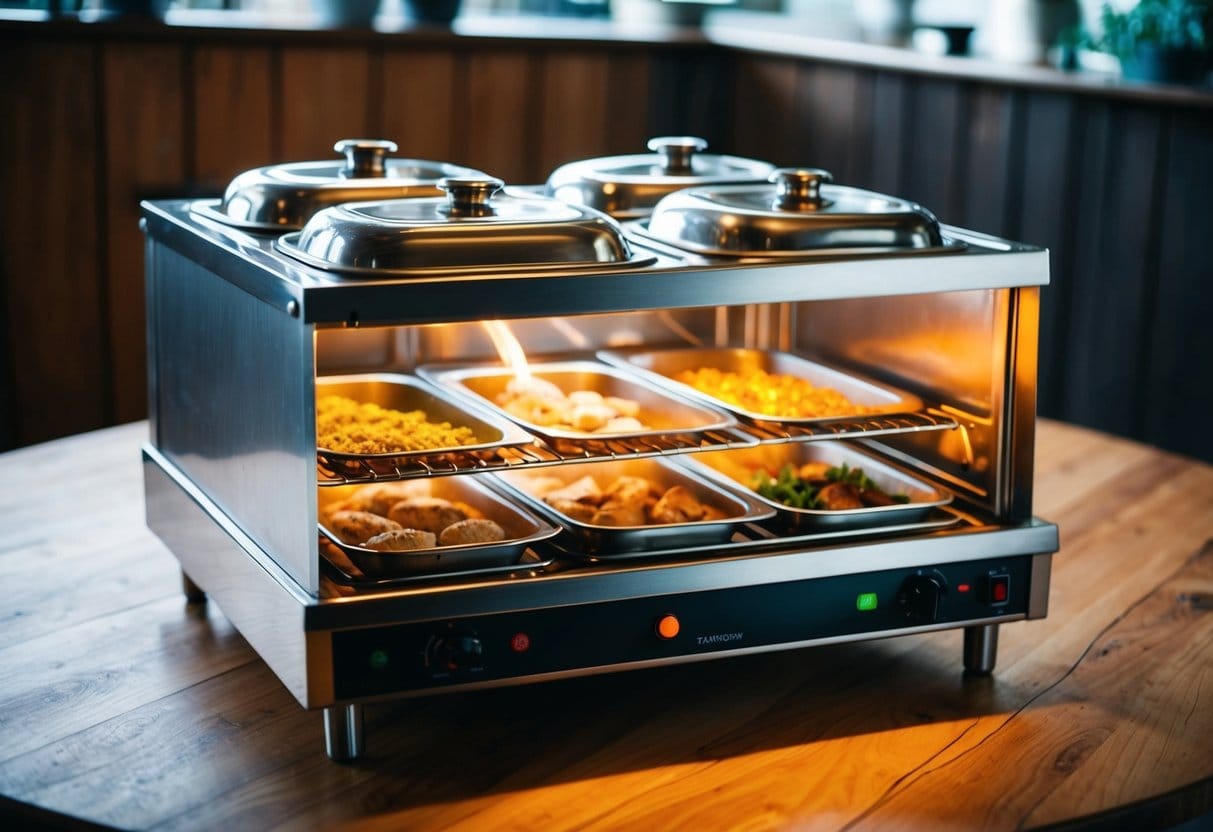Self-heating lunch boxes are revolutionizing the way we enjoy meals away from home. These innovative devices allow you to heat your food without access to a microwave or power outlet. With a self-heating lunch box, you can savor a warm, home-cooked meal anywhere.
We earn a commission if you purchase at no additional cost to you.
These portable self-heating lunch boxes use rechargeable batteries to power their heating elements. Many models can heat your food to optimal temperatures within 10-15 minutes, ensuring your meal is piping hot when you’re ready to eat. Some advanced versions even offer innovative features, automatically starting the heating process at a preset time so your food is prepared precisely when you want it.
These lunch boxes come in various sizes and designs to suit different needs. From compact options ideal for office workers to larger models perfect for outdoor enthusiasts, there’s a self-heating lunch box for every lifestyle. These devices provide convenience and encourage healthier eating habits by making it easier to bring nutritious homemade meals wherever you go.
Key Takeaways
- Self-heating lunch boxes provide hot meals anywhere without requiring external power sources
- They offer convenience and encourage healthier eating habits by making homemade meals portable
- Various models are available to suit different needs, from office use to outdoor activities
What Is a Portable Self-heating Lunch Box?
A self-heating lunch box is a portable container that warms up food without external heat sources. It uses built-in heating elements to provide hot meals anywhere.
Design and Functionality
Self-heating lunch boxes typically have multiple compartments to separate different dishes. They incorporate electrical heating elements powered by AC adapters or car chargers. Some models feature automatic timers, starting the heating process 2 hours before your scheduled mealtime.
You’ll find options for easy cleaning with adjustable temperature settings and removable inner containers. Many designs include insulation to keep food warm for extended periods. Some advanced models can even cook rice or other simple dishes.
Different Types
Electric lunch boxes come in various styles to suit different needs. Plug-in models connect to wall outlets or car sockets, ideal for office or travel use. Battery-powered versions offer greater portability but may have shorter heating times.
You can choose between single-tier boxes for individual meals or multi-layer designs for larger portions or multiple dishes. Some types require water for steam heating, while others use dry heat. Capacities range from compact personal-size sizes to larger boxes suitable for families or group outings.
Benefits of Using a Self-Heating Lunch Box
These battery-heated lunch boxes offer numerous advantages for busy professionals and students. These innovative devices allow you to enjoy hot meals anywhere, anytime, without relying on microwaves or other external heating sources.
Portability and Convenience
You can take your portable self-heating lunch box anywhere. It’s perfect for office workers, students, and travelers who want a hot meal on the go—no need to queue for microwaves or search for restaurants.
These devices are compact and easy to carry in your bag or backpack. Many models are leakproof, preventing messy spills during transport.
Self-heating lunch boxes typically heat food in 15-30 minutes. This gives you time to attend to other tasks while your meal warms up.
Health and Food Safety
Eating a hot meal can be more satisfying and healthier than cold alternatives. Self-heating lunch boxes allow you to bring home-cooked meals, giving you control over ingredients and portion sizes.
These devices maintain food at safe temperatures, reducing the risk of bacterial growth. This is especially important for foods like meat, dairy, and rice.
Some models have separate compartments for different foods, preventing cross-contamination and keeping textures intact.
Economic Advantages
By bringing your hot meals, you’ll save money on eating out. Restaurant lunches and takeaways can quickly add up over time.
Self-heating lunch boxes are a one-time investment that pays off in the long run. They’re durable and can last for years with proper care.
Reheating leftovers easily reduces food waste, helping you make the most of your grocery budget and reducing your environmental impact.
How to Choose the Right Self-Heating Lunch Box
Selecting an ideal self-heating lunch box involves considering several key factors. These include the container’s size and capacity, its construction quality, and the heating mechanism’s effectiveness and safety.
Capacity and Size
Choose a lunch box that fits your typical meal portions. Most models range from 1 to 2 liters in capacity. Consider how much food you usually pack and choose a size that accommodates your needs without being too bulky.
A compact design that easily fits a bag or briefcase is ideal for office workers. If you often carry multiple dishes, look for models with separate compartments or stackable containers.
Check the dimensions to ensure the lunch box fits comfortably in your workspace or vehicle. Some larger options may be better suited for family outings or group meals.
Material and Build Quality
Durability is crucial for a long-lasting lunch box. Stainless steel interiors are popular for their heat retention and ease of cleaning. Many are dishwasher safe, simplifying maintenance.
Look for leak-proof designs to prevent spills in your bag. Secure latches or tight-fitting lids are essential features. Some models offer silicone seals for added protection.
The exterior should be sturdy and heat-resistant. High-quality plastics or reinforced fabrics can provide insulation and withstand daily use. If you’re concerned about BPA, check for BPA-free materials.
Temperature Control and Safety Features
Adequate heating is the primary function of these lunch boxes. Look for models that warm food to safe temperatures, typically around 165°F (74°C). Some advanced options allow you to set specific temperatures.
Safety features are crucial. Auto shut-off prevents overheating, while cool-touch exteriors protect you from burns. Consider models with indicator lights that show when food is ready.
Choose a lunch box that is versatile and compatible with both car and wall outlets. This allows you to enjoy hot meals at the office or on the road.
Check for even heat distribution to avoid cold spots in your food. Some models use steam to heat food, which can help maintain moisture in your meals.
Usage Tips for Self-Heating Lunch Boxes
Self-heating lunch boxes offer convenience and hot meals on the go. Proper use ensures the best results and longevity of your device.
Preparing Your Meals
Choose foods that reheat well. Soups, stews, and rice dishes are ideal. Avoid items that may dry out or become soggy when reheated.
Pre-cook and portion your meals. Allow hot foods to cool before packing to prevent condensation.
Use microwave-safe containers that fit inside your lunch box. Many self-heating boxes come with divided compartments for different foods.
Consider adding a small amount of liquid to dishes to help steam and prevent drying. This works well for rice and pasta dishes.
Packing and Transportation
Ensure your lunch box is fully charged before use. Most models require 8-10 hours to charge completely.
Pack your food securely to prevent spills. Use leak-proof containers or silicone cupcake liners for small items.
Place your packed lunch box in an insulated bag for extra temperature retention.
Set your desired heating time before leaving home. Many models allow you to program when heating should begin.
Carry your lunch box upright to prevent leaks. Some models have carrying straps or handles for easy transport.
Cleaning and Maintenance
Clean your lunch box after each use. Wipe the interior with a damp cloth and mild soap.
Remove and wash any removable containers or compartments. Most are dishwasher-safe for easy cleaning.
Dry all components thoroughly before reassembling to prevent mold growth.
Regularly check and clean the heating element according to manufacturer instructions. This ensures efficient performance.
When not in use, store your lunch box in a cool, dry place. Keep the charging port clean and free from debris.
Replace seals or gaskets if they become worn to maintain proper heating and prevent leaks.
Leading Brands and Options
Self-heating lunch boxes offer convenient ways to enjoy hot meals on the go. Erroloda stands out as a popular choice, and comparing different options can help you find the best fit for your needs.
Erroloda
Erroloda is a leading brand in self-heating lunch boxes. Their portable food warmer uses a 4-pcs rechargeable lithium-ion battery totaling 16,000 mAh, providing 7-speed heating time from 20 to 80 minutes. This allows you to warm your meals anywhere without needing a power source.
The Erroloda self-heating lunch box is designed for convenience and efficiency. It features a 1L stainless steel container that evenly distributes heat. The temperature settings can be easily controlled to suit different types of food.
This rechargeable heated lunch box kit is a complete dining solution for meals on the go. The comprehensive set includes:
- Heated lunch box
- Cutlery set
- Fruit bowl
- Lunch divider
- Insulation bag
- Silicone screen protector
- USB charging cable
- Car charging head
One of the key features of this lunch box is that it doesn’t require adding water before heating, simplifying the process of enjoying a warm meal. With all the necessary components provided, this kit offers a perfect dining set for various situations, whether at work, during travel, or for outdoor activities. Including charging options for home and car use adds to its versatility, making it suitable for many users and scenarios.
Alternatives to Self-Heating Lunch Boxes
Self-heating lunch boxes aren’t the only option for enjoying warm meals away from home. Several alternatives offer convenient ways to keep food hot or reheat it on the go.
Electric Lunch Box
Electric lunch boxes provide a reliable way to heat meals. They can be plugged into standard outlets or car adapters, making them versatile for office or travel use.
These devices typically heat food in 20-30 minutes. Some models offer multiple power options, including 110V, 12V, and 24V compatibility. This flexibility allows you to use them in various settings, such as offices, schools, picnics, and camping trips.
Electric lunch boxes often feature leak-resistant seals to prevent spills. Many come with compartments to separate different food items. Some high-end models include features like timers and temperature controls for precise heating.
Insulated Thermal Bags
Insulated bags offer a simple, portable solution for keeping food warm. These bags use thermal insulation to maintain food temperature for several hours.
You’ll find various sizes and styles to suit different needs. Some feature multiple compartments to separate hot and cold items, and many are designed with sturdy, easy-to-clean materials.
Insulated bags are lightweight and don’t require power sources. This makes them ideal for outdoor activities, school lunches, or short trips. While they can’t reheat food, they’re effective at maintaining temperature when meals are packed hot.
Traditional Food Flasks
Food flasks, or thermal containers, are durable and efficient for keeping food hot. These vacuum-insulated containers can maintain food temperature for 4-6 hours.
Food flasks come in various sizes, from small portions to family-sized options. They’re versatile enough for soups, stews, pasta, and other hot meals. Many feature wide mouths for easy filling and eating directly from the container.
You’ll find models with built-in spoons or forks for added convenience. Some food flasks have separate compartments for storing accompaniments like bread or crackers. They’re ideal for outdoor workers, students, or anyone needing a reliable way to keep food hot without access to heating facilities.
Environmental Considerations
Self-heating lunch boxes raise critical environmental concerns. The convenience they offer comes with potential ecological drawbacks that you should consider.
These products often contain single-use heating elements, contributing to increased waste. The chemicals used in the heating process may also pose environmental risks if disposed of improperly.
Many self-heating lunch boxes are made from non-recyclable materials, adding to landfill waste. Whenever possible, look for options that use more sustainable packaging.
Energy consumption is another factor to weigh. While these lunch boxes don’t require external power sources, the manufacturing process of the heating elements can be energy-intensive.
Some brands are working to address these issues by developing more eco-friendly alternatives. For example, you might find options that use biodegradable materials or renewable energy sources for heating.
When choosing a self-heating lunch box, consider its reusability. Opting for a model that is dishwasher safe can extend its lifespan and reduce overall waste.
To minimize environmental impact, you can:
- Choose reusable self-heating lunch boxes when available
- Properly dispose of single-use components
- Look for products made from recycled or sustainable materials
- Consider alternative warming methods for your meals
By making informed choices, you can balance convenience with environmental responsibility when using self-heating lunch boxes.
Personal Experience
I’ve been using a self-heating lunch box for a few months now, and I have to say, it’s been a game-changer for my workday meals. The convenience of having hot food without access to a microwave is fantastic.
One of the things I love most is how it saves me time. I usually start heating my lunch about 30-45 minutes before I plan to eat, and it’s perfectly warm when I’m ready. On days when I have long shifts or work in remote locations, it’s great to know my food stays at a safe temperature for hours.
The battery comes with four lithium-ion batteries, which is decent, though I sometimes wish it had lasted longer. I’ve gotten into the habit of charging it every few days to be safe. Cleaning is pretty easy, too, since it is dishwasher-safe containers, which is a huge plus.
I hesitated initially because of the price. Shelling out $100 for a lunch box felt a bit extravagant, but now that I use it daily, I think it’s been worth the investment. The quality of heating is impressive – my meals warm evenly without any annoying hot spots you often get with microwaves.
Regarding portability, this size of 9.5″ x 8.66″ x 4.76″ is reasonably compact. However, I can see how some models might be too bulky for daily commuting.
All in all, I’m delighted with my self-heating lunch box. It’s become an essential part of my daily routine, and despite the initial cost, I feel it was a worthwhile purchase for its convenience.
Frequently Asked Questions
Self-heating lunch boxes offer convenience, but users often question their functionality and capabilities. These FAQs address common concerns about heat retention, battery life, food safety, etc.
How long can a self-heating lunch box retain its heat?
Most self-heating lunch boxes can warm food for 2-3 hours after heating. The exact duration depends on factors like initial food temperature and ambient conditions. Some models with advanced insulation may maintain heat for up to 6 hours.
What is the average battery life of a battery-powered self-heating lunch box?
Battery-powered self-heating lunch boxes typically last 4-6 hours on a single charge. Higher-end models may offer up to 8 hours of use. Battery life varies based on heating intensity and frequency of use.
Are self-heating lunch boxes safe to use for all types of food?
Self-heating lunch boxes are generally safe for most foods. However, avoid using them for raw meats or highly perishable items. Stick to pre-cooked meals and foods safe at room temperature for extended periods.
How do self-heating lunch boxes with timers work?
These lunch boxes allow you to set a specific heating time. You input your desired mealtime, and the box automatically starts heating at the appropriate moment. This ensures your food is warm and ready precisely when you want to eat.
Can self-heating lunch boxes also keep food cold?
Some models offer dual functionality for both heating and cooling. These versions use thermoelectric technology to switch between warming and chilling modes. You can keep your salads crisp or your drinks cool in the same container that heats your main course.
What are the differences between a steam box and a thermal lunch box?
Steam boxes use water to create steam, heating food more evenly and maintaining moisture. Thermal lunch boxes rely on insulation to retain heat from pre-warmed food. Steam boxes often provide quicker heating but require water, while thermal boxes are more straightforward but may not heat as effectively.
Before You Go
While a self-heating lunch box is perfect for enjoying hot, freshly heated meals on the go, a table food warmer takes your dining experience to the next level by keeping multiple dishes warm and ready to serve at home. Ideal for family meals, gatherings, or even everyday use, it ensures that every bite stays at the perfect temperature. Explore how this practical addition can elevate your mealtime convenience and make hosting a breeze.





